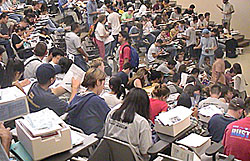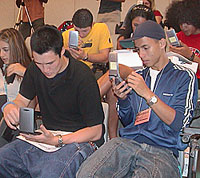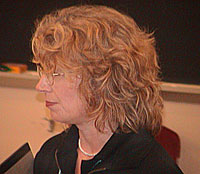"When You Get Stuck, Check Your Journada!"
 Students at 6th College's orientation program. |
9.26.02 -- This was one of the comments heard on a 7-minute video edited from student experiences over a three-day orientation period earlier this week at Sixth College. Sixth, the newest of UCSD's colleges that serve as the residential "homes" and determine graduation requirements for every UCSD student, accepted its first class of students this week.
The experience was dubbed "Explorientation" by Jeremy Weir, one of the students working on the project and a summer Calit² undergraduate research fellow. Explorientation is a play on words on the standard notion of college orientation and the underlying software architecture, called ActiveCampus Explorer, that the students used on handheld devices. Clearly, there was something new going on here.
To launch this experiment, 285 freshman were issued wirelessly enabled HP Jornada personal digital assistants - many donated by HP, the rest supplied by Calit² - to support their investigation over the next four years of Sixth College's theme of Art, Culture, and Technology.
The Explorientation application was developed and directed by Adriene Jenik, an associate professor of Visual Arts, with assistance from Weir and Jolene Truong, another Calit² undergraduate research fellow. It is a set of six PDA-based "challenges" that teams of students responded to so as to acquaint themselves with UCSD's campus - both today and its history over the last 40 years - before classes started. It represents an exciting extension of formative work done by a team led by Bill Griswold, a professor of Computer Science and Engineering of the UCSD Jacobs School and leader of the Interfaces and Software Systems layer at Calit².
|
Griswold's team of faculty and students represents, true to the Calit² spirit, a broad range of disciplines, including Computer Science and Engineering, Visual Arts, Cognitive Science, and Communication. This team previously had developed ActiveCampus Explorer, upon which Explorientation is built, which helps students find resources, including their wirelessly connected "buddies," on campus, based on their locations, time of day, and their personal interests.
Says Griswold, "Adriene built on ActiveCampus to enable her own work and extend Calit²'s Ubiquitous Connectivity 'living lab.' I'd call this a good example of peer-to-peer collaboration."
Matt Ratto, another member of the team, is a graduate student in the Communications Department doing an ethnographic study, under the direction of professor Leigh Star, on how the students use the PDAs with other technologies. At the kick-off session at which the students received their PDAs, he said, "This is the most amazing thing seeing a few hundred students in a single lecture hall, all working to understand how this new wireless technology might fit into their lives."
And what did the students experience? Weir describes Explorientation as consisting of "somewhat structured tasks with a dash of competition thrown in. We expected the students would learn more about their campus in a few days than some students do in four years, plus they would have fun and get to know each other."
The challenges encouraged the students to explore the campus looking for white flags posted on places and people, and, when they found one, to enter the phrase on the flag into their PDAs; study clues to identify past UCSD alums; organize themselves in space in a visually compelling way from an aerial perspective; identify "negative" spaces on campus that lack wireless connectivity; locate prizes; and submit their best ideas on how to improve the application. For each challenge, points were allocated, and prizes overall were awarded at the conclusion of the three days.
Jenik, who also edited the Explorientation videotape, says, "We're looking forward to analyzing data we collected of the event - observational, computational, and anecdotal. We plan to make another video that is more thorough and includes some of the many interviews we have conducted with students. This is really just the beginning of the experiment."
|
Sixth College Provost Gabriele Wienhausen has spent the last two years planning how to bring the theme of the college to fruition and determining what technological infrastructure that required. She says, "We're trying to help students become knowledgeable about - and at ease with - technology. We also expect they'll develop the ability to articulate what technology can and cannot do."
No one involved in this project claims to be able to predict how the students will use the technologies. Looking for near-term benefits, though, indicates that it may be the students themselves who will provide the early "return" on this investment.
Says Wienhausen, "Our students will help UCSD understand the pitfalls of technology and whether the campus has the infrastructure in place to not only support their needs but plan for the future needs of the campus more generally."
*This phrase comes from original music composed by Sarabella and Irie Ivan (and produced by the Lumin8tor) for the Explorientation highlight reel.
Related Links
Explorientation
6th College
Photo Gallery
Related Articles
Welcome 2002 Undergraduate Fellows



